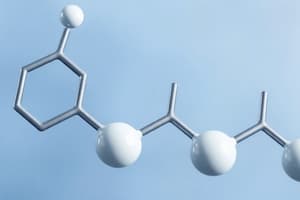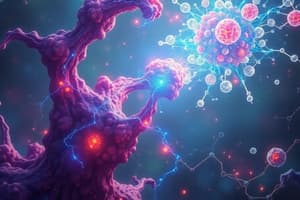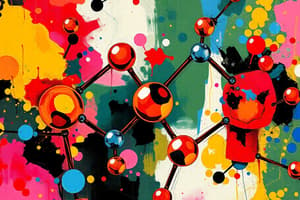Podcast
Questions and Answers
Which of the following statements accurately describes the relationship between bond order, bond length, and bond strength?
Which of the following statements accurately describes the relationship between bond order, bond length, and bond strength?
- As bond order increases, bond length increases and bond strength decreases.
- Bond order has no direct correlation with bond length or bond strength.
- As bond order increases, bond length decreases and bond strength increases. (correct)
- As bond order decreases, both bond length and bond strength decrease.
Consider a molecule with resonance. Which statement best describes the true structure of this molecule?
Consider a molecule with resonance. Which statement best describes the true structure of this molecule?
- The molecule exists as a mixture of all possible resonance structures in equilibrium.
- The molecule primarily exists as the most stable resonance structure.
- The molecule rapidly interconverts between all possible resonance structures.
- The molecule exists as a single structure that is a hybrid or average of all resonance structures. (correct)
Which of the following factors primarily determines the stability of carbocations?
Which of the following factors primarily determines the stability of carbocations?
- Inductive effect and hyperconjugation. (correct)
- Resonance and inductive effect.
- Hyperconjugation and electromeric effect.
- Electromeric effect and resonance.
How does hyperconjugation differ from resonance?
How does hyperconjugation differ from resonance?
Which statement best describes the electromeric effect?
Which statement best describes the electromeric effect?
What is the primary difference between structural isomers and stereoisomers?
What is the primary difference between structural isomers and stereoisomers?
Which of the following conformers has the highest energy?
Which of the following conformers has the highest energy?
According to the Bronsted-Lowry definition, what characterizes a base?
According to the Bronsted-Lowry definition, what characterizes a base?
Identify the functional group present in the compound with the formula $R-COOR'$?
Identify the functional group present in the compound with the formula $R-COOR'$?
Which chromatographic technique is most appropriate for separating volatile organic compounds?
Which chromatographic technique is most appropriate for separating volatile organic compounds?
Flashcards
Hybridization
Hybridization
Mixing atomic orbitals to form hybrid orbitals for bonding.
Inductive Effect
Inductive Effect
Polarization of a sigma bond due to electronegativity differences.
Resonance
Resonance
Delocalization of pi electrons in a molecule, increasing stability.
Hyperconjugation
Hyperconjugation
Signup and view all the flashcards
Electromeric Effect
Electromeric Effect
Signup and view all the flashcards
Carbocation
Carbocation
Signup and view all the flashcards
Carbanion
Carbanion
Signup and view all the flashcards
Free Radical
Free Radical
Signup and view all the flashcards
Isomers
Isomers
Signup and view all the flashcards
Enantiomers
Enantiomers
Signup and view all the flashcards
Study Notes
- General organic chemistry (GOC) involves fundamental principles governing the structure, properties, and reactions of organic compounds.
- Organic compounds are primarily composed of carbon and hydrogen, but may also contain other elements such as oxygen, nitrogen, sulfur, and halogens.
Bonding in Organic Compounds
- Carbon's tetravalency is fundamental; it forms four covalent bonds.
- Carbon can form single, double, and triple bonds with other carbon atoms and other elements.
- Hybridization describes the mixing of atomic orbitals to form new hybrid orbitals suitable for bonding.
- sp3 hybridization: Carbon atom bonded to four other atoms (single bonds), tetrahedral geometry, 109.5° bond angles.
- sp2 hybridization: Carbon atom bonded to three other atoms (one double bond), trigonal planar geometry, 120° bond angles.
- sp hybridization: Carbon atom bonded to two other atoms (one triple or two double bonds), linear geometry, 180° bond angles.
- Sigma (σ) bonds are formed by end-on overlap of atomic orbitals, stronger and allow free rotation.
- Pi (π) bonds are formed by sideways overlap of p orbitals, weaker and restrict rotation.
- Bond length decreases with increasing bond order (single > double > triple).
- Bond strength increases with increasing bond order (single < double < triple).
Inductive Effect
- The inductive effect is the polarization of a σ bond due to electronegativity differences between atoms.
- Electron-donating groups (+I effect) release electron density through the sigma bond.
- Electron-withdrawing groups (-I effect) pull electron density through the sigma bond.
- The inductive effect decreases with increasing distance from the substituent.
Resonance
- Resonance is the delocalization of π electrons in a molecule.
- Molecules with resonance structures are more stable.
- Resonance structures are connected by curved arrows showing electron movement.
- Resonance hybrid is the actual structure of the molecule, representing the average of all resonance contributors.
- Resonance contributors must have the same atomic connectivity.
- Resonance contributors must have the same number of paired and unpaired electrons.
- More stable resonance structures have: more complete octets, less charge separation, negative charge on more electronegative atoms, positive charge on less electronegative atoms.
Hyperconjugation
- Hyperconjugation is the delocalization of σ electrons from a σ bond (usually C-H or C-C) to an adjacent empty or partially filled p orbital or π orbital.
- Stabilizes alkenes and carbocations, also influences the conformation of alkanes.
- Greater the number of alpha hydrogens, the greater the hyperconjugation.
- Hyperconjugation is similar to resonance but involves sigma bonds.
Electromeric Effect
- Temporary effect observed in presence of attacking reagent.
- Involves the complete transfer of π electrons to one atom in a polyatomic system.
- +E effect: π electrons move to the atom to which the reagent attacks.
- -E effect: π electrons move away from the atom to which the reagent attacks.
Types of Organic Reactions
- Addition reactions: Two reactants combine to form a single product.
- Elimination reactions: Atoms or groups are removed from a molecule, forming a multiple bond.
- Substitution reactions: One atom or group is replaced by another.
- Rearrangement reactions: Atoms or groups are rearranged within the same molecule.
Reaction Intermediates
- Carbocations: positively charged carbon atoms with six electrons.
- Stability of carbocations: 3° > 2° > 1° > methyl, due to inductive effect and hyperconjugation.
- Carbanions: negatively charged carbon atoms with eight electrons.
- Stability of carbanions: methyl > 1° > 2° > 3°, due to inductive effect.
- Free radicals: species with an unpaired electron.
- Stability of free radicals: 3° > 2° > 1° > methyl, due to hyperconjugation.
- Carbenes: neutral species with a carbon atom having two substituents and two non-bonding electrons.
- Nitrenes: nitrogen analog of carbenes.
Isomerism
- Isomers are molecules with the same molecular formula but different structural or spatial arrangements of atoms.
- Structural isomers (constitutional isomers) have different connectivity.
- Chain isomers: differ in the arrangement of the carbon chain.
- Position isomers: differ in the position of a substituent or functional group.
- Functional group isomers: have different functional groups.
- Metamers: differ in the alkyl groups attached to the same functional group.
- Tautomers: Structural isomers that readily interconvert.
- Stereoisomers have the same connectivity but differ in spatial arrangement.
- Enantiomers: non-superimposable mirror images.
- Diastereomers: stereoisomers that are not mirror images.
- Conformational isomers (conformers) differ by rotation around sigma bonds.
- Newman projection and Sawhorse representation are used to visualize conformers.
- Eclipsed, staggered, gauche, and anti conformations.
- Baeyer's strain theory: explains the stability of cycloalkanes based on angle strain.
- Sachse-Mohr theory explains the absence of angle strain in larger cycloalkanes due to puckered ring conformations.
Nomenclature
- IUPAC nomenclature provides a systematic way to name organic compounds.
- Identify the parent chain (longest continuous carbon chain).
- Number the parent chain to give substituents the lowest possible numbers.
- Name and number the substituents.
- Combine the substituent names and numbers with the parent chain name.
Acids and Bases
- Arrhenius acids produce H+ in water, and Arrhenius bases produce OH- in water.
- Bronsted-Lowry acids are proton donors, and Bronsted-Lowry bases are proton acceptors.
- Lewis acids are electron pair acceptors, and Lewis bases are electron pair donors.
- Factors affecting acidity: electronegativity, size, resonance, inductive effect, hybridization.
- Stronger acids have weaker conjugate bases, and stronger bases have weaker conjugate acids.
- pKa is a measure of acid strength; lower pKa values indicate stronger acids.
- Acid-base reactions favor formation of the weaker acid and weaker base.
Functional Groups
- Alkanes: contain only single bonds.
- Alkenes: contain at least one carbon-carbon double bond.
- Alkynes: contain at least one carbon-carbon triple bond.
- Alcohols: contain a hydroxyl (-OH) group.
- Ethers: contain an oxygen atom bonded to two alkyl or aryl groups (R-O-R').
- Aldehydes: contain a carbonyl group (C=O) bonded to at least one hydrogen atom.
- Ketones: contain a carbonyl group (C=O) bonded to two alkyl or aryl groups.
- Carboxylic acids: contain a carboxyl group (-COOH).
- Esters: contain a carbonyl group bonded to an alkoxy group (-COOR).
- Amines: contain a nitrogen atom bonded to one, two, or three alkyl or aryl groups.
- Amides: contain a carbonyl group bonded to a nitrogen atom.
- Nitriles: contain a cyano group (-CN).
- Halides: contain a halogen atom (F, Cl, Br, I) bonded to a carbon atom.
Chromatography
- Chromatography is a separation technique based on differential distribution of substances between a stationary phase and a mobile phase.
- Substances with different affinities for the stationary phase will travel at different rates.
- Common types include thin-layer chromatography (TLC), column chromatography, gas chromatography (GC), and high-performance liquid chromatography (HPLC).
Studying That Suits You
Use AI to generate personalized quizzes and flashcards to suit your learning preferences.




